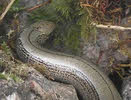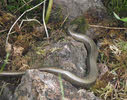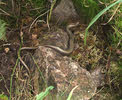

The slow worm is not as many mistakenly believe a snake but a legless burrowing lizard. It is also known as a blindworm and it is believed its name comes from the fact it eats worms, ‘slayer of worm’ becoming slow worm.
 The slow worm does indeed look like a snake with smooth scales which aid burrowing underground and lacking a distinctively separate head. Males can be grey to brown or bronze (occasionally with blue spots after 3 years) with a pale underside whereas females are browner or golden with a black stripe down their back and a dark blue/black underside. They grow up to 50cm long with a fairly thick upper body especially on the females, and like many lizards they can shed their tail to escape predators although it doesn’t fully grow back giving some slow worms an almost stunted appearance. Finally, unlike snakes, they have eyelids and visible ears. Slow worms are arguably the longest living lizard with an estimated 30 years in the wild and a male slow worm in Copenhagen Zoo reaching 54 years.
The slow worm does indeed look like a snake with smooth scales which aid burrowing underground and lacking a distinctively separate head. Males can be grey to brown or bronze (occasionally with blue spots after 3 years) with a pale underside whereas females are browner or golden with a black stripe down their back and a dark blue/black underside. They grow up to 50cm long with a fairly thick upper body especially on the females, and like many lizards they can shed their tail to escape predators although it doesn’t fully grow back giving some slow worms an almost stunted appearance. Finally, unlike snakes, they have eyelids and visible ears. Slow worms are arguably the longest living lizard with an estimated 30 years in the wild and a male slow worm in Copenhagen Zoo reaching 54 years.
Slow worms are active during the day but tend not to bask openly like other reptiles as they fear predators (most commonly domestic cats). They will bask under a piece of metal or plastic placed in the garden in a sunny spot as the objects act as heat collectors, they can also be found burrowed into compost heaps where the soft matter allows them to burrow easily and contains prey such as worms and slugs as well as being warm, so be careful when digging your compost!
 Slow worms hibernate in the UK from October to late February/ early March, sometimes alone, sometimes in groups or even with other reptiles. Although mating occurs earlier in the year, slow worms don’t normally conceive until June. Some fighting over females occurs among the males although a female will mate with several males during a season. Between half and a full dozen young are normally born but much larger births have been known, they are born live in an egg sack which they then break out of. I have found them not to be aggressive animals and are gentle creatures if carefully handled, normally curling around your hand for warmth, I have never known a slow worm to bite.
Slow worms hibernate in the UK from October to late February/ early March, sometimes alone, sometimes in groups or even with other reptiles. Although mating occurs earlier in the year, slow worms don’t normally conceive until June. Some fighting over females occurs among the males although a female will mate with several males during a season. Between half and a full dozen young are normally born but much larger births have been known, they are born live in an egg sack which they then break out of. I have found them not to be aggressive animals and are gentle creatures if carefully handled, normally curling around your hand for warmth, I have never known a slow worm to bite.
Habitat
As a species it is found all over Europe and as far east as Iran, although they are not found in the far north of Europe, Ireland or Southern Spain. In the UK they are most prevalent in Wales and south west England. They like warm humid places especially domestic garden compost heaps but also found in woodland and meadows.
Prey
 Slow worms as their name indicates are not fast predators but hunt slow moving prey such as slugs , snails and worms (and garden pests so encourage them into your garden!) which they will often hunt following rain as worms come to the surface and are easier to hunt.
Slow worms as their name indicates are not fast predators but hunt slow moving prey such as slugs , snails and worms (and garden pests so encourage them into your garden!) which they will often hunt following rain as worms come to the surface and are easier to hunt.